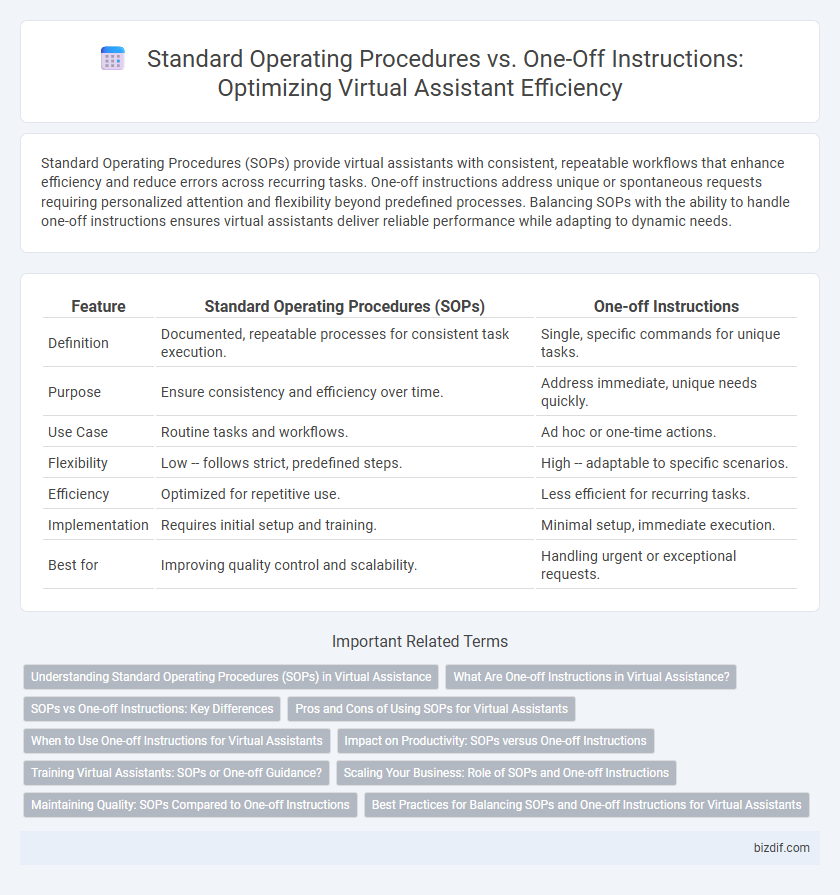Standard Operating Procedures (SOPs) provide virtual assistants with consistent, repeatable workflows that enhance efficiency and reduce errors across recurring tasks. One-off instructions address unique or spontaneous requests requiring personalized attention and flexibility beyond predefined processes. Balancing SOPs with the ability to handle one-off instructions ensures virtual assistants deliver reliable performance while adapting to dynamic needs.
Table of Comparison
| Feature | Standard Operating Procedures (SOPs) | One-off Instructions |
|---|---|---|
| Definition | Documented, repeatable processes for consistent task execution. | Single, specific commands for unique tasks. |
| Purpose | Ensure consistency and efficiency over time. | Address immediate, unique needs quickly. |
| Use Case | Routine tasks and workflows. | Ad hoc or one-time actions. |
| Flexibility | Low -- follows strict, predefined steps. | High -- adaptable to specific scenarios. |
| Efficiency | Optimized for repetitive use. | Less efficient for recurring tasks. |
| Implementation | Requires initial setup and training. | Minimal setup, immediate execution. |
| Best for | Improving quality control and scalability. | Handling urgent or exceptional requests. |
Understanding Standard Operating Procedures (SOPs) in Virtual Assistance
Standard Operating Procedures (SOPs) in virtual assistance provide a structured framework of repeatable tasks and guidelines designed to ensure consistency and quality in service delivery. Unlike one-off instructions that address unique or immediate tasks, SOPs streamline workflow by minimizing errors and training time through detailed step-by-step processes. Implementing SOPs enhances efficiency, accountability, and scalability in virtual assistant operations by standardizing routine activities.
What Are One-off Instructions in Virtual Assistance?
One-off instructions in virtual assistance are specific, non-repetitive tasks assigned for immediate completion without integration into ongoing workflows. These instructions differ from standard operating procedures (SOPs), which define routine processes and guidelines for consistent task execution. One-off instructions often address unique or urgent requests, requiring quick adaptation from the virtual assistant to meet distinct client needs efficiently.
SOPs vs One-off Instructions: Key Differences
Standard Operating Procedures (SOPs) provide consistent, repeatable guidelines for tasks, ensuring uniformity and efficiency across operations, while one-off instructions address unique, singular actions without ongoing application. SOPs are documented, formalized processes designed for routine execution, whereas one-off instructions are typically informal and context-specific. Organizations relying on SOPs enhance training, compliance, and quality control, unlike those using only one-off instructions that risk variability and inefficiency.
Pros and Cons of Using SOPs for Virtual Assistants
Standard Operating Procedures (SOPs) offer virtual assistants consistency and efficiency by providing clear, repeatable guidelines for routine tasks, reducing errors and training time. However, SOPs may limit flexibility and creativity when handling unique or unexpected situations that require adaptability and personalized responses. Balancing SOP use ensures virtual assistants maintain high productivity while still accommodating one-off instructions for specialized tasks.
When to Use One-off Instructions for Virtual Assistants
One-off instructions for virtual assistants are ideal for tasks that are infrequent, unique, or require immediate action without the need for repetition. These instructions ensure efficient handling of specific requests without the overhead of creating detailed standard operating procedures. Using one-off instructions streamlines workflows for ad hoc assignments, minimizing time spent on task setup and maximizing responsiveness.
Impact on Productivity: SOPs versus One-off Instructions
Standard Operating Procedures (SOPs) enhance productivity by providing consistent, repeatable processes that reduce errors and training time for virtual assistants. One-off instructions often lead to inefficiencies due to the need for constant clarification and re-explanation, increasing the risk of miscommunication. Implementing SOPs ensures a streamlined workflow, enabling virtual assistants to perform tasks more efficiently and reliably.
Training Virtual Assistants: SOPs or One-off Guidance?
Training virtual assistants using Standard Operating Procedures (SOPs) ensures consistent task execution by providing detailed, repeatable workflows tailored to specific functions such as customer service or data entry. One-off instructions may suffice for unique, infrequent tasks but lack the scalability and efficiency required for comprehensive virtual assistant management. Implementing SOPs enhances accuracy, streamlines onboarding, and reduces errors, making them crucial for sustained virtual assistant productivity.
Scaling Your Business: Role of SOPs and One-off Instructions
Standard Operating Procedures (SOPs) provide a consistent framework that streamlines virtual assistant tasks, essential for scaling your business by ensuring efficiency and quality across repetitive processes. One-off instructions address unique or situational tasks, offering flexibility but lacking the repeatable structure necessary for sustainable growth. Combining SOPs with targeted one-off directions optimizes operational scalability by balancing routine automation with adaptive problem-solving.
Maintaining Quality: SOPs Compared to One-off Instructions
Standard Operating Procedures (SOPs) ensure consistent quality by providing detailed, repeatable guidelines for virtual assistants to follow, reducing errors and variability in task execution. One-off instructions, while flexible for unique tasks, often lead to inconsistent outcomes due to lack of standardized processes. Maintaining quality relies heavily on the structured framework SOPs offer, enabling scalability and reliability in virtual assistant performance.
Best Practices for Balancing SOPs and One-off Instructions for Virtual Assistants
Effective management of Virtual Assistants requires balancing Standard Operating Procedures (SOPs) with one-off instructions to ensure consistency while allowing flexibility for unique tasks. Implementing clear SOPs standardizes routine processes, enhances efficiency, and reduces errors, whereas well-documented one-off instructions address specific, non-repetitive requests without disrupting workflow. Regularly updating SOPs based on recurring one-off tasks optimizes performance and leverages virtual assistant capabilities for dynamic business needs.
Standard Operating Procedures vs One-off instructions Infographic

 bizdif.com
bizdif.com